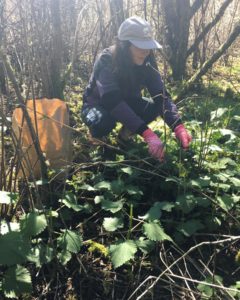Meet Fireweed (Chamaenerion angustifolium). It likes to grow in community and is easy to celebrate as its flowers transform the landscape into a sea of pink. Fireweed is a pioneer species, one of the first plants to colonize a space after a disturbance such as a forest fire or clear cut. In the ugliness of destruction, it brings beauty, hope, and abundance – it has even been found growing in bomb craters after World War II, around Mount St. Helens after its eruption, and on oil spill sites. Fireweed ushers in new life by attracting a wide variety of pollinators (I counted at least five species of bees while harvesting), providing food and habitat for other animals, and regenerating soil by fixing nitrogen and inhibiting erosion. This process makes way for other plants to establish themselves, and as ecological complexity grows and succession progresses, the fireweed quietly dies off.
Beyond being a light in the darkness, fireweed has further applications. The thousands of fluffy seeds that fireweed produces were traditionally used as a down stuffing for blankets, mattresses, clothing, cushions, etc. The young inner stalk is a traditional food of many Indigenous groups. Young leaves and flowers are nutritious and can also be eaten, though the leaves get fibrous and less palatable as they age, or made into a tea. The leaves can also be fermented to make a tea drink named Koporye or Ivan tea, which tastes like black tea but without the caffeine. Medicinally, fireweed leaves and flowers are anti-inflammatory and can be used both internally and externally for that purpose. Taken internally, fireweed is also beneficial to the gut flora and is useful for treating candida overgrowth in the digestive tract.
Fireweed is best harvested for food in springtime and for medicine in July. This year I harvested quite late and many of the plants were finished blooming; however, the plants that had been topped by other harvesters or grazing animals had grown side shoots, which were still vibrantly flowering. In this clearcut I also found some evergreen huckleberry, salal, Scotch broom, and red alder saplings. So exciting to see how plants will heal and transform the land.








